FRACTURE OF SHAFT
OF ULNA
In 1814, Monteggia described a fracture of the ulna associated with
dislocation of the proximal radioulnar joint. A direct blow to, or forced
pronation of, the forearm is the usual cause of this type of fracture-
dislocation. Forced pronation both fractures and angulates the ulna, and then
causes the radial head to dislocate.
Bado classified the patterns of
dislocation that occur with Monteggia fractures. Although the radial head
usually dislocates anteriorly, it can also move posteriorly, medially, or laterally.
The apex of the angular deformity of the ulna usually indicates the direction
of the radial head dislocation. Because of the close relationship of the
proximal radius to the posterior interosseous nerve, a posterior interosseous
nerve palsy is not uncommon after a Monteggia fracture.
Like the Galeazzi, or Piedmont,
fracture, the Monteggia fracture in adults is difficult or impossible to treat
with closed methods. Achieving a stable reduction of the radial head usually
requires ORIF of the fracture of the proximal ulna.
Treatment of the Monteggia fracture
is often complicated by a variety of difficulties. Occasionally during ORIF of
the ulna, the radial head does not reduce. By far the most common cause for
this is improper reduction of the ulna fracture, and this should always be
evaluated first. Proper technique is required to ensure stable fixation and
avoid nonunion and loss of reduction. When open reduction of the radial head is
required, one should suspect incarcerated tissue (including the possibility of
the posterior interosseous nerve) which requires removal from the
radiocapitellar and proximal radioulnar joints. When an open reduction is
needed, the torn annular ligament should also be repaired to help stabilize the
proximal radioulnar joint. When the ulna fracture is severely comminuted, it is
difficult to restore the bone to its proper length, and the reduced length
creates a significant problem in reducing the radial head.
Failure to recognize and treat
Monteggia fractures soon after injury can lead to restrictions in elbow and
forearm motion. Late surgical treatment includes osteotomy of the ulna to
restore length and geometry, as well as reconstruction of the annular ligament
using the triceps brachii fascia r other local soft tissue to stabilize the
proximal radius.





